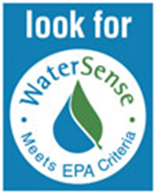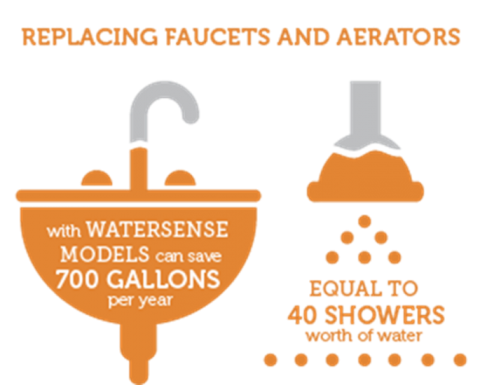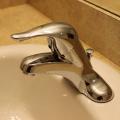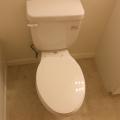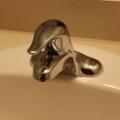Scope
Install WaterSense® labeled bathroom sink faucets and accessories, which can reduce a sink's water use by 30 percent without sacrificing performance. All bathroom sink faucet manufacturers are required by law to mark their products with the maximum flow rate. For more information on reducing bathroom faucet water use, see Leaks in Water-Using Fixtures.
WaterSense labeled homes are required to have WaterSense labeled bathroom sink faucets or faucet accessories (e.g., aerators). To earn the WaterSense label, a faucet must have a flow rate that does not exceed 1.5 gallons per minute (gpm) at a pressure of 60 psi at the inlet when water is flowing. Additionally, the flow rate shall be no less than 0.8 gpm at a pressure of 20 psi at the inlet when water is flowing.
See the Compliance Tab for links to related codes and standards and voluntary federal energy-efficiency program requirements.
Description
For a home to earn the WaterSense® label, all bathroom sink faucets or faucet accessories must be WaterSense labeled. A lavatory faucet accessory is a device that can be added to or removed from a bathroom sink faucet (typically, it screws onto the tip of the faucet spout). Faucet accessories frequently serve as the flow control mechanism that determines if a faucet meets the flow rate requirements of the WaterSense specification. Faucet accessories control flow rate either through flow restriction (narrowing the opening through which the water is discharged from the faucet) or flow regulation (adapting the width of the opening through which the water is discharged based on fluctuations in water pressure to maintain a constant flow rate; Figure 1).
Faucet accessories include:
- Aerators: Add air into the water stream to increase the sensation of flow (this is the most common type of faucet accessory).
- Laminar flow devices: Force the water through small openings to produce dozens of parallel water streams, creating a more uniform flow and potentially reducing splash.
- Other types of flow restrictors: Control flow through means other than aerating the water stream or creating laminar flow.
- Other types of flow regulators: Control flow through means other than aerating the water stream or creating laminar flow, but also compensate for changes in water pressure.
To earn the WaterSense label, a bathroom sink faucet or faucet accessory must have a maximum flow rate of 1.5 gpm when tested at 60 psi and a minimum flow rate of 0.8 gpm when tested at 20 psi (Figure 2). WaterSense included the minimum flow rate requirement to ensure a high level of performance in locations with very low water pressure.
Third party verifiers will obtain a list of the make and model numbers for all bathroom sink faucets and faucet accessories installed in the home and verify that they have earned the WaterSense® label. The verifier will also check the maximum flow rate of all bathroom and kitchen faucets to ensure that the aerators have not been tampered with or removed. To conduct the test, the verifier will place a small bucket or a flow-measuring bag under the faucet spout, and turn on the water completely while starting a stopwatch (Figure 2). After 10 seconds, the verifier will turn off the water and check the volume of water collected. The volume of water should be 0.25 gallons or less for bathroom sink faucets.
All faucets and attachable accessories are required by the ASME A112.18.1/CSA B125.1 performance standard to be marked with their maximum flow rate. Checking the faucet marking will indicate if a bathroom sink faucet meets the WaterSense maximum flow rate, but not the minimum flow rate. To determine if the product meets all aspects of the WaterSense specification, look for the WaterSense label on the product packaging and documentation. The specification requires these products to bear the WaterSense label.
The WaterSense website also provides a listing of labeled faucets and accessories here.
Success
Bathroom and kitchen faucets account for approximately 15.7 percent of indoor residential water use in the United States (Figure 1), which equates to about 1.1 trillion gallons of water used annually. The Energy Policy Act of 1992 originally set the maximum flow rate for both lavatory and kitchen faucets at 2.5 gpm at 80 psi static pressure. In 1994, ASME A112.18.1M-1994–Plumbing Supply Fittings set the maximum flow rate for lavatory (bathroom) faucets at 2.2 gpm at 60 psi. In response to industry requests for conformity with a single standard, in 1998, the U.S. Energy Department adopted the 2.2 gpm at 60 psi maximum flow rate standard for all faucets (both kitchen and bathroom). Other than this maximum flow rate standard, there currently are no universally accepted performance tests or specifications (i.e., rinsing or wetting performance standards) for faucets.
Climate
No climate specific information applies.
Training
Compliance
Compliance
ENERGY STAR New Homes and Apartments
Environmental Protection Agency (EPA) WaterSense® Home Specification
See the EPA WaterSense product search website for a list of labeled faucets and accessories.
For more information. see the U.S. Department of Energy's Standard Work Specifications regarding Water Use Reduction.
Retrofit
Guidance for the measures described in this guide is applicable to both new and existing homes.
For more information, see the U.S. Department of Energy’s Standard Work Specifications regarding Water Use Reduction.
More
More Info.
Access to some references may require purchase from the publisher. While we continually update our database, links may have changed since posting. Please contact our webmaster if you find broken links.
Sales
Low Flow Fixtures =

Water-conserving fixtures reduce water usage and the amount of energy needed to heat that water. Faucets and showerheads are designed to save water but provide the same experience as typical fixtures. The WaterSense label (from the U.S. Environmental Protection Agency) takes the guesswork out of choosing the right fixture.
